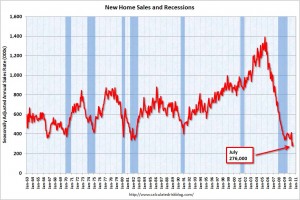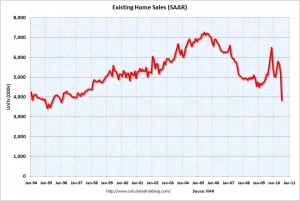Home » Housing (Page 2)
Category Archives: Housing
Bob Shiller on confidence and the economy
Bob Shiller, economics professor at Yale University and a pioneer in behavior finance talks about the importance of confidence in economic recovery. He thinks with lingering high unemployment, the national morale is sinking.
And we have to admit we simply do not know many things in the working of our economy.
Housing market is dreadful
New home sales is making new historical lows,
and existing home sales reached the lowest level since 1996.
(click to enlarge; graph courtesy of Calculatedrisk)
After the expiration of home buying credit, this was expected. But the magnitude of decline still shocked people. Due to slow sales, inventory of unsold homes starts to ramp up again.
And this is happening despite historically low mortgage rate. Two things might be working against potential home buyer’s psychology: 1) Is my job secure? 2) Will the house price keep falling?
(click to enlarge; graph courtesy of Northern Trust)
How to watch China bubble
Ed. Chancellor of GMO (in Boston) has put out an excellent piece on the Chinese market and the “red flags” for investors.
The paper addresses how to identify the proper “speculative manias” and associated financial crises in the country. Chancellor sums it into key points, breaking down the bare essentials:
1. Great investment debacles generally start out with a compelling growth story.
2. A blind faith in the competence of the authorities is another typical feature of a classic mania. In other words, you can’t always trust the numbers that a government is putting out.
3. A general increase in investment is another leading indicator of financial distress. Capital is generally misspent during periods of euphoria.
4. Great booms are invariably accompanied by a surge in corruption. Countrywide, anyone?
5. Strong growth in the money supply is another robust leading indicator of financial fragility. Easy money lies behind all great episodes of speculation from the Tulip Mania of the 1630s – which was funded with IOUs – onward.
6. Fixed currency regimes often produce inappropriately low interest rates, which are liable to feed booms and end in busts.
7. Crises generally follow a period of rampant credit growth. In the boom, liabilities are contracted that cannot subsequently be repaid. The U.S. will ultimately be a perfect example of this.
8. Moral hazard is another common feature of great speculative manias. Greed isn’t necessarily good and we tend to act irresponsible during intense periods of speculation.
9. A rising stock of debt is not the only cause for concern. Investments financed with borrowed money don’t generate enough income to either service or repay the loan (what Minsky called “Ponzi finance”).
10. Dodgy loans are generally secured against collateral, most commonly real estate. Thus, a combination of strong credit growth and rapidly rising property prices are a reliable leading indicator of very painful busts.
Cost of home ownership
A Great chart on the history of cost of home ownership (courtesy of Visual Economics).
As measured by the percentage of income devoted to mortgage payment, we are at historical low. This is a great time to own a house.
Caution to house speculators: do not hope for a quick price recovery.











![Reblog this post [with Zemanta]](https://img.zemanta.com/reblog_e.png?x-id=b31d3ec4-cae4-4753-82d0-3ff4fa548917)